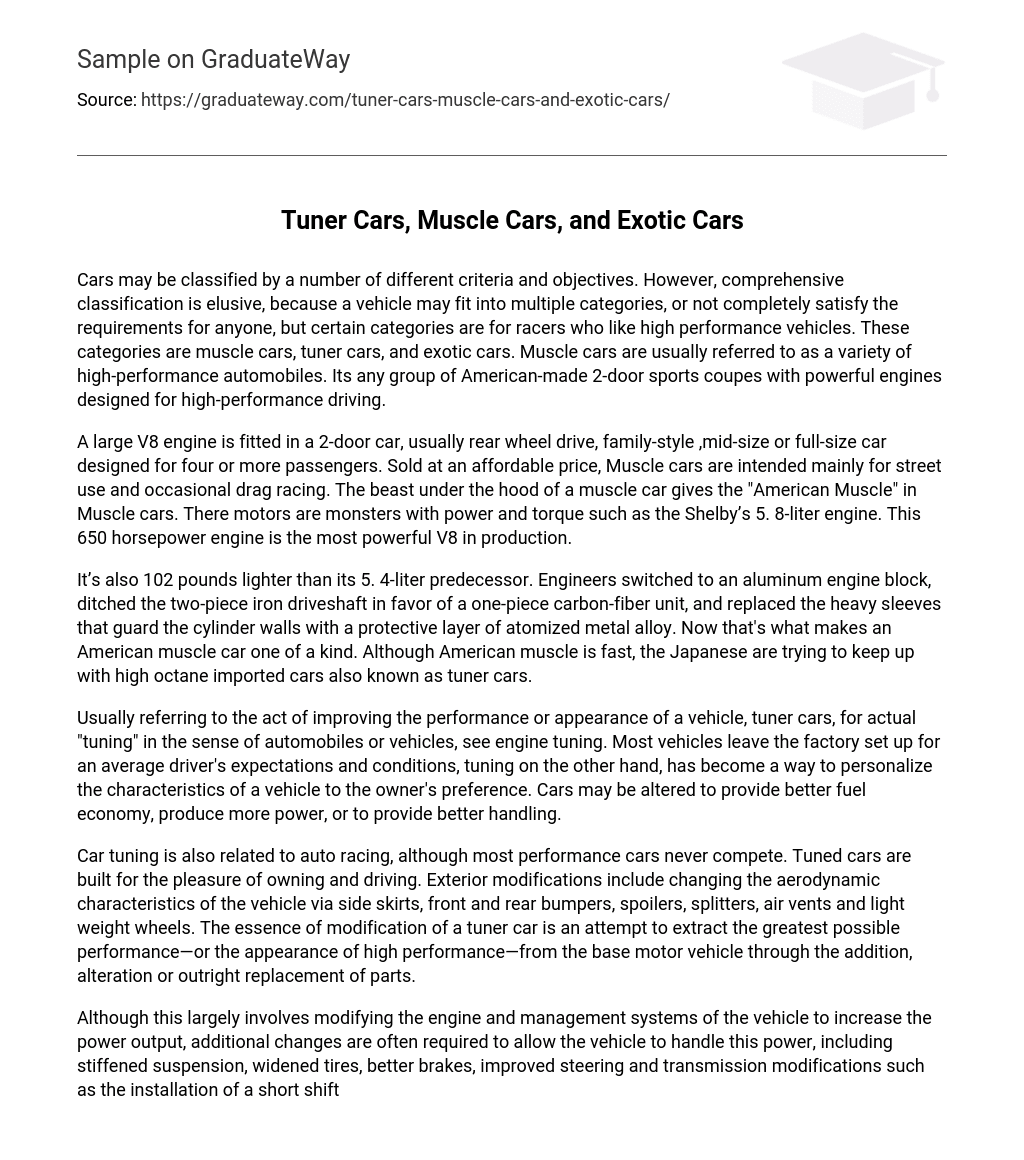Cars can be classified based on various criteria and objectives, but achieving a comprehensive classification is difficult due to a vehicle’s potential to fall into multiple categories or not fully meet certain requirements. However, specific categories cater to race car enthusiasts who prefer high-performance vehicles. These categories include muscle cars, tuner cars, and exotic cars. Muscle cars typically refer to a range of powerful American-made 2-door sports coupes designed for high-performance driving.
A muscle car is a 2-door car with a large V8 engine, typically rear wheel drive, designed to accommodate four or more passengers. They are classified as family-style, mid-size or full-size cars that are offered at an affordable price. These cars are mainly built for street use and occasional drag racing. The power and torque of the engine in a muscle car is what contributes to its renowned reputation as “American Muscle.” These engines, exemplified by Shelby’s 5.8-liter engine, possess immense power similar to monstrous machines. In fact, Shelby’s 5.8-liter engine currently holds the title for being the most potent V8 in production with an impressive output of 650 horsepower.
The American muscle car is now 102 pounds lighter than its 5.4-liter predecessor. The engineers made several changes to achieve this. They replaced the aluminum engine block, replaced the two-piece iron driveshaft with a one-piece carbon-fiber unit, and replaced the heavy sleeves protecting the cylinder walls with a protective layer of atomized metal alloy. All these modifications make the American muscle car truly unique. However, the Japanese are also trying to keep up by creating high octane imported cars, also known as tuner cars.
The term “tuner cars” typically refers to the act of enhancing a vehicle’s performance or appearance. For actual automotive tuning, as it pertains to engines or vehicles, please see engine tuning. By default, most vehicles are designed to meet the expectations and conditions of the average driver. However, tuning has emerged as a means of customizing a vehicle’s traits according to the owner’s preferences. This can involve modifications aimed at improving fuel efficiency, increasing power output, or enhancing handling capabilities.
Car tuning is closely associated with auto racing, even though the majority of performance cars are not used for competitive racing. Tuned cars are designed to provide enjoyment in ownership and driving. Exterior alterations encompass modifications to the vehicle’s aerodynamic features, achieved by adding side skirts, front and rear bumpers, spoilers, splitters, air vents, and lightweight wheels. The core objective of modifying a tuner car is to maximize performance, or at least create the perception of heightened performance, by adding, modifying, or completely replacing components.
Modifying the engine and management systems of a vehicle is mainly done to increase power output. However, additional changes are often necessary to ensure the vehicle can handle this increased power. These changes include stiffened suspension, wider tires, improved brakes, enhanced steering, and transmission modifications like installing a short shifter. Even though some modifications like low profile tires, altered suspension, and added spoilers may not be visible from the outside, they can significantly alter the car’s overall appearance.
Engine tuning is the act of altering the performance and emissions of an engine by adjusting its operating characteristics. This involves modifying mechanical and electronic components like the intake manifold, spark plugs, Mass air flow/Volume air flow, and more. Nowadays, engines utilize an ECM to optimize the balance between performance and emissions. Through the OBD communications protocol, the electronically controlled aspects of the engine can be modified through a process called ‘mapping’.
There are two methods to complete the mapping process: modifying the software in the Engine Control Unit (ECU) through firmware modification, also known as chip tuning, and using plug-in hardware to provide false data, commonly referred to as piggybacking. Additionally, mechanical components like turbochargers or superchargers can be replaced. Lastly, Exotic cars, also called Supercars, are expensive high-end vehicles known for their exceptional speed and power accompanied by excellent handling. They should also have an attractive appearance and be priced in a rarefied atmosphere of their own.
The term “supercar” is subjective and disputed among enthusiasts. These vehicles are typically marketed as unusual by automakers. They can take various forms, including limited production specials from elite automakers and standard looking cars with hidden power and performance. Some models cater to hardcore enthusiasts from manufacturers on the fringe of the car industry. “Supercar” is also a label used by custom car retrofitters for their unique project vehicles, often extensively modified collectible muscle cars, sports cars, or grand touring automobiles. These vehicles feature very powerful engines, such as Lamborghini’s sixty degree V12 petrol engine, which was the firm’s first internal combustion engine. In conclusion,





